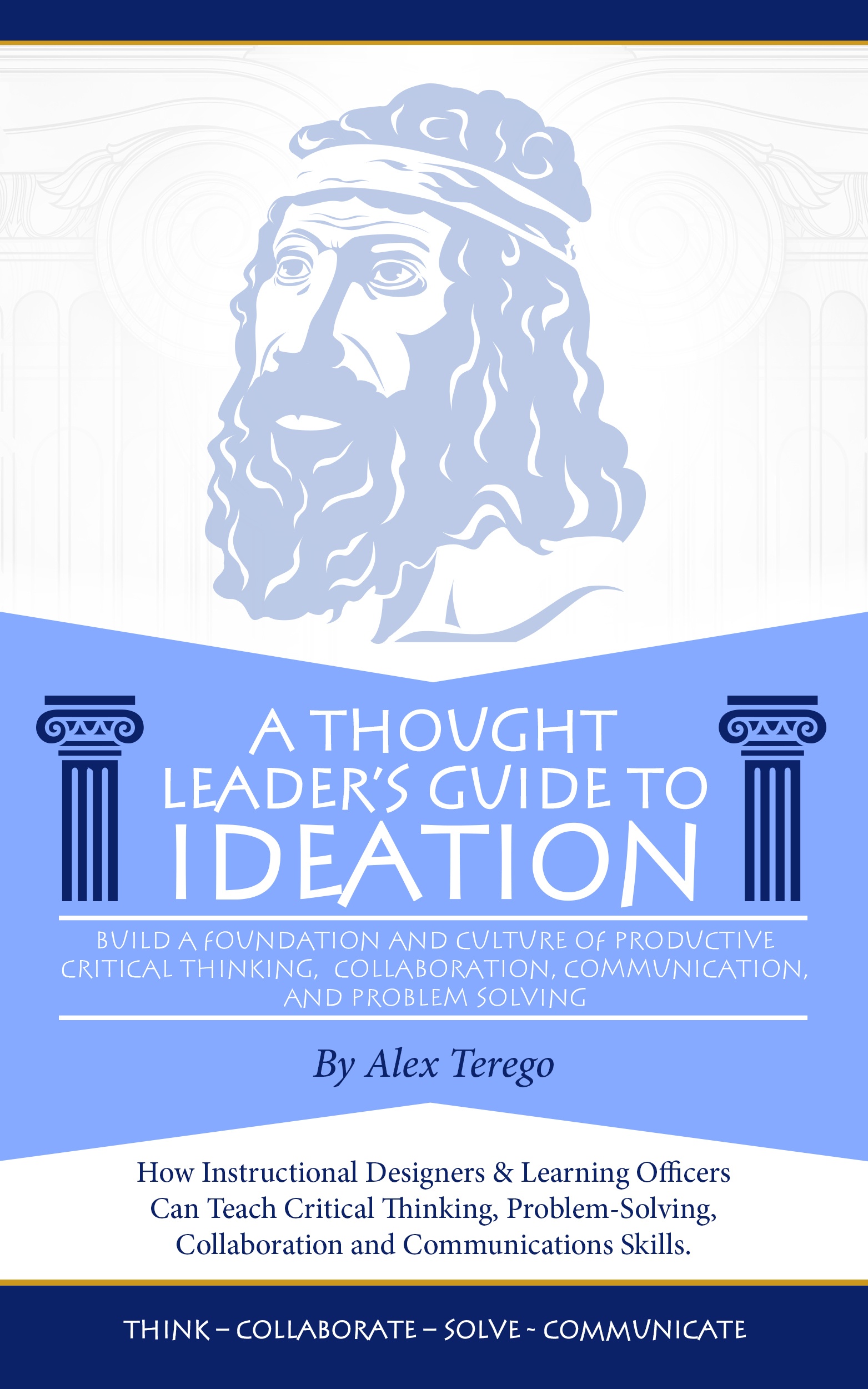The Crucial Importance Of Storytelling In Learning
Alex Terego, founder of Terego Enterprise Training, is allowing our readers to read portions of his work. This article comes from his book Instructional Designers and Learning Officers: A Thought Leader's Guide to Ideation.
Carmine Gallo writes in Inc. Magazine, “Our brains are hardwired for narrative…. It’s a survival mechanism….Stories are persuasive.” Why? Because we are social and emotional creatures, as well as logical humans. Ideation springs from credible sources, acted upon by logic of course; but emotion necessitates connecting with others to ideate first, and second to remember that idea. And only narratives are as much about emotion as logic. Not bullet points.

Bezos is not alone. Other CEOs—including Google’s—agree that stories inform, illuminate, inspire and, most importantly, the message becomes memorable.
The conclusion? Even the most mundane of topics—perhaps especially the most mundane topics—can best be transmitted by narrative. With that in mind...
Here’s A Narrative Structure: A Story Of True Ideation
It was a dark and stormy meeting. The lights flickered in the fourth floor conference room as a storm raged outside.
The mood was grim. A long-simmering problem had developed into a full-blown crisis. Customers were no longer just complaining; they were taking their business elsewhere.
The CEO had issued a terse two-word command to the Customer Service Department: “Fix it!”
All the managers, supervisors, and especially the front-line reps from the customer service department, were dismayed and anxious. The room was silent except for whisperings.
“What do we do?” One person spoke up, finally, asking the question that was on everyone’s mind.
“What can we do?” Another asked, shrugging his shoulders.
“Who’ll pay our salaries if the customers keep jumping ship?” a Millennial pleaded, on the verge of tears.
“I heard that the Sales and Marketing folks can no longer make up the difference” added a distraught middle-aged woman, “and I’m now taking care of my grandchildren.” Her shoulders heaved and her voice cracked.
Her grim-faced colleagues looked at her sympathetically, helpless to give her any comfort.
The meeting was in disarray. Solutions to this chronic problem were nowhere to be found. The mood was somber.
The thunderstorm intensified and shook the building. Dread was now added to the mix of emotions.
At that moment an elderly white-bearded man with a pot belly, wearing only a toga and sandals, materialized in their midst. He looked around and smiled. Unbidden, he addressed the distraught gathering, “You’re asking the wrong questions.” His eyes were smiling comfortingly, “But you’re on the right track. Asking questions is the right approach.”
Intrigued, the others in the room quickly forgot the materialized stranger’s incongruous appearance and gathered around him.
“Tell us the solution,” the highest ranking person in the room pleaded, desperate for any help they could get.
“I can’t,” the stranger replied, “The only thing I know is that I know nothing.” He smiled enigmatically.
The people in the room were confused by this response. How could someone who knows nothing help? Nonetheless, they drew nearer to this avuncular sage with the strange accent. There was something about him.
“What does he mean?” one person ventured.
“I think he means we have to find out for ourselves,” a senior manager proffered hopefully.
Another volunteered, “If he’s right then, if we figure out what’s wrong first, we can convince others that our solution is best.”
“He said we were on the right track. But what does he mean?” added the grandmother.
There was a brief silence. But then the pace picked up until a rapid fire exchange was underway.
“Well, he did say that we were asking the wrong questions.”
“But he did say to ask questions,” offered one woman hopefully.
“Yes, but what are the right questions?” someone said.
“Who’ll go first?” added another.
“I will,” the Millennial broke the silence, and said hopefully, “How many ways can we ask questions?”
This question seemed baffling and irrelevant, even alien, to the throng.
“Well, we have to start somewhere, so let’s address that question first,” volunteered a woman who seemed to be stepping into the leadership role.
After some debate they all agreed that the only way to make sure that all the right questions get asked and answered was by asking questions beginning with the words Who, What, Why, Where, When, and How; and to ask and answer as many of those questions as they could. A glimmer of hope ignited some energy into the group.
The mysterious guest smiled encouragingly.
“I’ll go first. I have a question.” It was the Millennial speaking. “Who should be in this meeting?”
They all looked at one another as if they had just switched the lights on.
“Wow!” was all one could say, before adding, “We’re all doing the same job. Everyone here’s in customer service.”
“We all have the same perspective”
“There’s no diversity in this group. That can’t be good.”
After a long pause, and almost as one voice, they answered their own question.
“We need to ask our customers why they’re dissatisfied.”
The leadership lady added, “We need to ask sales and engineering, product design and management too.”
They began hugging. Light had appeared at the end of the tunnel. And more questions followed. And they didn’t stop with one answer, they interrogated their own answers until satisfied.
They soon had customers, product management, engineering, and salespeople on Skype, and the questions flew. And the answers came. The old sage smiled, indicating satisfaction with the group’s progress. And he nodded as the questions flew.
“What’s a customer?” the emboldened Millennial demanded.
“Why do they matter?” added someone else.
“They’re other businesses and people that make our business possible,” came the answer.
“What happens after a bad customer service experience?” wondered one.
“A bad experience is shared more times than a good one,”
“And it affects everybody.”
“What do you mean everybody?”
“I remember in my business classes in college they talked about five stakeholders: shareholders, employees, board, customers, and one other,” the speaker paused, “Ah yes, suppliers.”
More people were invited to join the discussion, and the energy flowed.
“More connections equal more ideas,” observed the woman, who by now was leading the discussion.
She had been scribbling on Post-it notes as the team discovered where the company was failing and why.
She began to place Post-it notes in categories above, beneath and to the sides of the issue that one member had thoughtfully written in the middle of the whiteboard:
“Why Do Customers Matter?”
The diagram almost built itself. Pretty soon the team had all the questions asked and answered, and the team leader said,“What now?”
The young woman who had asked previously how many ways a question could be asked piped up again. “Why don’t we vote on which are the best answers?”
Astonished at the simplicity of this suggestion, the other members agreed, and the Post-it lady called for a ballot.
She then moved the eight Post-it notes with the most votes onto a separate part of the whiteboard, and then asked for help turning the eight notes into a paragraph outlining the group’s opinion on why their customer service was so bad, and what the group unanimously recommended should be done about it.
They did. One young man who had not spoken much volunteered a concluding thought, which got all the team members nodding in agreement. “I guess that’s what I’ve heard called Ideation. And it’s sure better to just do it rather than listen to someone banging on about it.”
The team leader agreed and said. “I think I would summarize it this way. Ask a question. Answer it, and then question the answer,” she paused, “And then do it all over until you get the right result.”
“It sure takes the guesswork out of problem-solving,” added the Millennial.
The man in the toga and sandals inclined his head to each participant, his eyes twinkling, and then began to dissolve before their very eyes.
“Who was that man?” The wide-eyed Millennial asked the question on all their minds.
The lady who had led the team looked at the whiteboard in astonishment as a reed pen wrote the name “Σωκράτης.”
So! If you enjoyed the story and learned from it, and would like to see what an actual team did step-by-step, and the narrative they wrote addressing the issue of customer service watch this narrated video of the Terego Ideation Method©. PowerPoint does have its uses.
To become a Thought Leader Expert in this Ideation Methodology get my book for Instructional Designers and Learning Officers.
P.S. My Terego Ideation Game is coming in late 2018.
B.T.W. That was Socrates in the room.
And don’t forget – Connect with me on LinkedIn.









